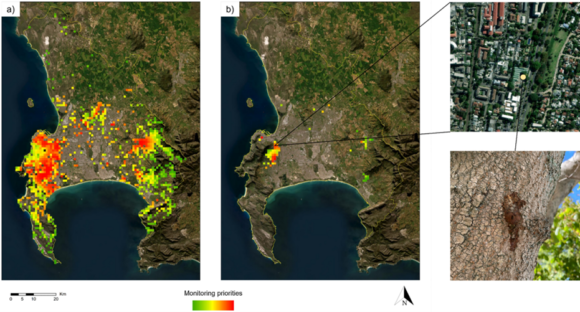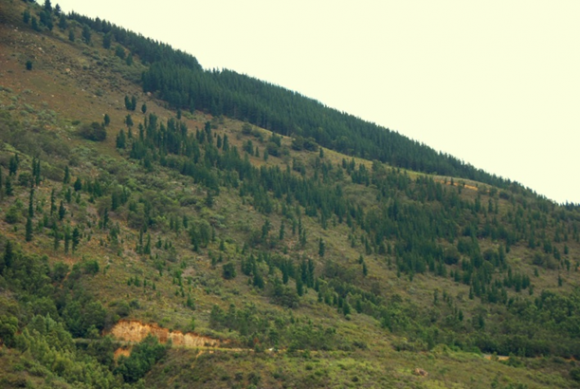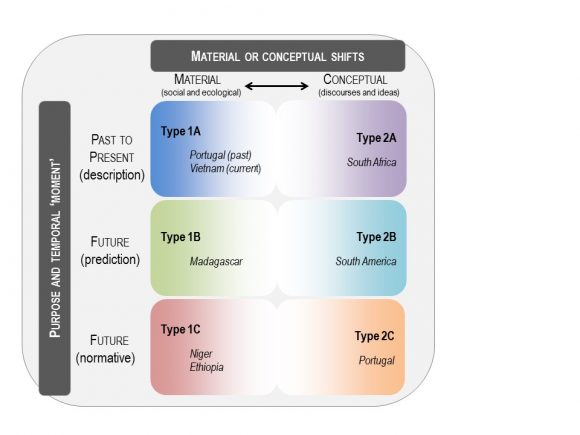1 February 2024 | By Dr Luke Potgieter and Prof Dave Richardson
Ecologists at Stellenbosch University’s Centre for Invasion Biology and the Department of Conservation Ecology and Entomology have developed an innovative monitoring protocol to map priority areas for detecting new and expanding polyphagous shot hole borer (PSHB) infestations in urban areas.
The protocol, published in the Journal of Pest Science this week, used data from the popular citizen science initiative iNaturalist that were collected as part of the “Reproductive hosts at risk of PSHB in South Africa” project. To date more than 4 100 South African citizen scientists have made 35 144 observations of at-risk trees.
Luke Potgieter, a postdoctoral research fellow at the Centre for Invasion Biology and the lead author on the study, said they decided to use Cape Town and Stellenbosch as case studies to illustrate how a platform such as iNaturalist can be used together with additional city-level spatial datasets to map priority areas for monitoring of PSHB infestations.
Using citizen science to map priority areas
They first accessed a dataset of 9 000 iNaturalist observations of PSHB-reproductive host tree species in and around Stellenbosch and Cape Town. Both cities have recently experienced PSHB infestations (2019 and 2022 for Cape Town and Stellenbosch respectively), and in both urban areas there are significant concerns and interest in PSHB due to the importance of many high-value, but also highly susceptible, trees.
From the list of susceptible tree species, the Box Elder (Acer negundo) was identified as a sentinel species for the detection of possible PSHB infestations. This non-native tree species is relatively abundant in urban areas in South Africa, and initial symptoms of infestations are relatively easy to detect.
They then mapped those facilities which could most likely act as dispersal nodes for PSHB populations, such as arborist facilities, firewood distributors, general waste facilities, green waste facilities, landfills, mature tree nurseries, and refuse transfer stations. This dataset was obtained from the City of Cape Town Open Data Portal and identified through consultation with local arborists and municipal workers, and their own observations.
By combining these datasets, they were able to map priority areas where high densities of PSHB-reproductive hosts (and Box Elder separately as a sentinel species for monitoring and surveillance) were found growing close to plant biomass facilities. To provide more detailed operational guidance for practitioners, high-priority roads were also identified for visual and baited trap surveys.
What are the priority areas for Stellenbosch and Cape Town?
According to the study, priority areas include Cape Town’s Central Business District and the southern suburbs which lie on the north- and south-eastern slopes of Table Mountain, respectively. Most of the urbanised parts of Stellenbosch are priority areas.
Potgieter says they are confident that the management protocol is working: “A recent visual survey of a high-priority site identified in our protocol detected a new PSHB infestation outside a nursery where a number of Box Elders are growing.”
Prof Dave Richardson, an ecologist at SU’s Centre for Invasion Biology and one of the co-authors, says citizen science platforms could play a major role in helping to manage one of the world’s most devastative wood borers.
Richardson is himself an avid contributor to iNaturalist, with over 42 000 observations and counting!
Read the paper in Journal of Pest Science
Potgieter, L.J., Cadotte, M.W., Roets, F. and Richardson, D.M. (2024) Monitoring urban biological invasions using citizen science: the polyphagous shot hole borer (Euwallacea fornicatus). J Pest Sci (2024). https://doi.org/10.1007/s10340-024-01744-7
Further media links
News24: Stellenbosch, Cape Town infestation used to develop new protocol on invasive beetle.
For more information, contact Luke Potgieter at Luke Potgieter lukepotgieter2@gmail.com, or Prof Richardson at rich@sun.ac.za




